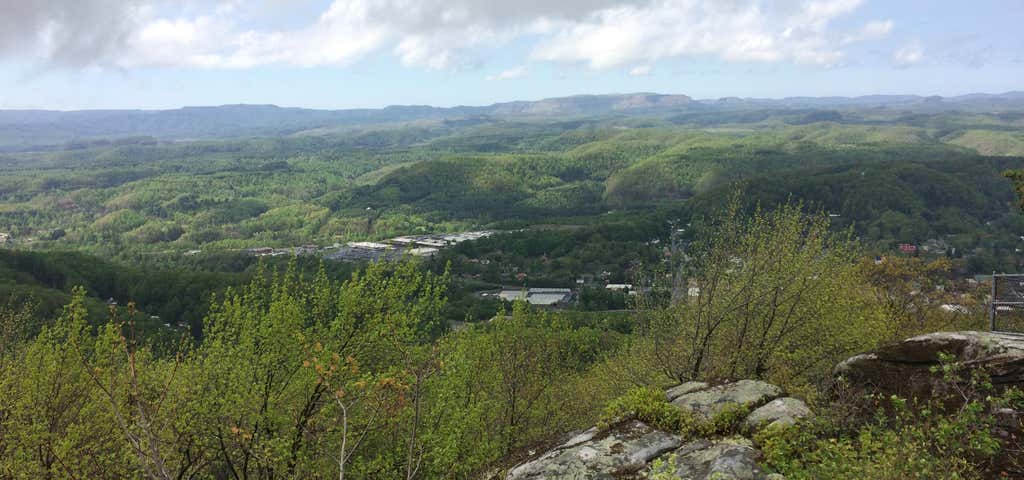Written by Malee Oot
Spread over the ridges and valleys of Appalachia, Southwest Virginia lays claim to some of the Old Dominion state’s most spectacular natural wonders. The region is blanketed by massive swaths of the Jefferson National Forest, threaded by the oldest waterway in the U.S., and crowned by the highest peak in the state. Southwest Virginia is also celebrated as the birthplace of country music, spearheaded by legends like the Carter Family and the Stanley Brothers. Then, there’s moonshine. During Prohibition, the region was notorious for flooding markets along the East Coast with illicit spirits—and drew the scrutiny of the Federal Bureau of Investigation, earning Southwest Virginia’s Franklin County a reputation as the “Moonshine Capital of the World.”
With Appalachian peaks, wild ponies, moonshine lore, and plenty of country music legends, there’s no shortage of myths and marvels to experience on this journey through Southwest Virginia.
Nestled into Garden Mountain like a divine thumbprint, Burke’s Garden is Virginia’s highest valley and the state’s largest rural historic district. Spread across approximately 40 miles, the geological anomaly is a repository of Native American history, scattered with archaeological sites dating to the early Archaic period. While James Burke was surveying the valley in 1748, he buried some vegetable peels and inadvertently planted potatoes; the following year, the mountain-cradled basin was jokingly named in honor of Burke’s rogue spuds. These days, the upland valley is a hub for cyclists; for hikers, the Appalachian Trail traces the ridges of Garden Mountain, offering views of Burke’s Garden from the Chestnut Knob shelter.
2
Twin Creeks Distillery
The Blue Ridge Mountains are awash with moonshining legends, fed by a distilling tradition dating back more than two centuries. During the 1700s, European settlers brought long-enduring distilling traditions to the region, and quickly realized the benefits of distilling spirits such as brandy and whiskey instead of brewing beer. In the early 1920s, after Prohibition became federal law, Virginia’s swath of the Blue Ridge Mountains emerged as a hotspot for illicit hooch; the rugged landscape was perfect for stashing secret stills, and a rich distilling industry was already in place. Twin Creeks Distillery in Rocky Mount is helmed by Chris Prillaman, a descendent of James Walter Hatcher, one of the defendants in the Moonshine Conspiracy Trial of 1935.
3
Breaks Interstate Park
Spread over the panoramic Pine Mountain range, Breaks Interstate Park is one of just two interstate parks in the entire country. Shared by Virginia and Kentucky, the protected area is anchored by a 5-mile-long chasm in Pine Mountain, one of the largest and deepest gorges east of the Mississippi River. The rugged landscape was once a hunting ground for the region’s early Cherokee and Shawnee inhabitants, and later was traversed by westbound pioneers. Today, the park also helps manage Virginia’s only wild elk herd. Reintroduced in 2012, the herd roams a reclaimed strip mine, now blanketed with woodland-edged meadows. For visitors, the park offers elk-viewing safaris during fall mating season and in the spring, when the elk are calving.
Bigfoot sightings are usually associated with the Pacific Northwest, but the Southeast also has plenty of myths about the hulking woodland creature. Sasquatch encounters have been reported throughout Southwest Virginia since the end of the Civil War, even prompting a visit from the Bigfoot Field Researchers Organization (BFRO). Following the BFRO’s expedition, the city of Norton declared the Flag Rock Recreation Area an official “Woodbooger Sanctuary” in 2014, a nod to the creature’s local nickname. For aspiring cryptozoologists hoping to spy a resident woodbooger, the Flag Rock Area Trails network offers 10 miles of singletrack spread over the flanks of High Knob, open to mountain bikers, hikers, and runners. However, visitors are more likely to encounter the recreation area’s endemic green salamanders, the only tree climbing salamanders found in Virginia.
5
Carter Family Fold
With a musical legacy stretching back nearly a century, the Carter Family has rightfully been celebrated as the first family of country music. Although the original group had disbanded by the 1940s, the music continued, and Johnny Cash became inextricably linked to the family after marrying June Carter. Today, the family’s musical dynasty continues at the Carter Family Fold in Hiltons. Opened in 1979, the venue celebrates the region’s traditional music, particularly bluegrass and country.
6
Burger Bar
Bristol has plenty of country music lore. Straddling the border of Virginia and Tennessee, the town hosted the 1927 Bristol Sessions, a catalytic set of recordings featuring the debuts of the Carter Family and Jimmie Rodgers. The town also has a morbid legend: Hank Williams may have uttered his last words in Bristol, while being chauffeured from Knoxville to Ohio for a performance. On the evening of Williams’ death, his driver Charles Carr rolled into Bristol around midnight for gas. After noticing the Burger Bar, Carr asked Williams if he wanted a bite to eat. According to Carr’s telling, the country legend declined, and stayed in the car. A few hours later, Williams was pronounced dead at a hospital in Oak Hill, West Virginia. However, several stories of Williams’ pit stop in Bristol exist, including one rumor that he went into the Burger Bar to eat. Whichever story is true, the burger joint still celebrates the legend with menu items named for Williams’ songs.
Originally a private residence for the family of Francis Preston, a brigadier general during the War of 1812, the property now known as the Martha Washington Inn & Spa has anchored downtown Abingdon for more than 180 years. Constructed in 1832, the mansion was purchased and transformed into Martha Washington College, a prestigious school for girls in 1858. In 1935, the property was converted into a hotel, catering to a parade of distinguished guests, including Harry Truman, Jimmy Carter, and Elizabeth Taylor. Today, the Preston family’s original residence still forms the inn’s main structure, although modern amenities including a spa, lighted tennis courts, and heated saltwater pool have been added.
8
Barter Theatre
The Barter Theatre opened during the Great Depression and weathered the country’s tumultuous economic downturn. The vision of Southwest Virginia native and actor Robert Porterfield, the playhouse opened on June 10, 1933, and allowed patrons to pay their 40 cent theatre admission with all manner of goods, including livestock and produce. In 1946, the playhouse was declared the State Theatre of Virginia, and despite its small town location, the venue has hosted an array of legendary performers, including Ernest Borgnine, Ned Beatty, Gregory Peck, and Patricia Neal. With a full calendar of performances throughout the year, the Barter Theatre is among the longest-running professional theatres in the country.
9
The Tavern Restaurant
Originally a stop for travelers on The Great Stage Road, a stagecoach route linking Washington, D.C., and Nashville, the Tavern opened in 1779, and has been a fixture in the town of Abingdon ever since. Housed in the oldest building in Abingdon, the edifice’s east wing once served as the first post office west of the Blue Ridge, and during the Civil War, the Tavern’s attic housed wounded soldiers. According to local legend, the property’s lingering supernatural visitors include Captain Gordon William Rife, who was purportedly shot on the grounds of the Tavern when it was still a hotel, and a woman dubbed the “Tavern Tart,” who has reportedly been spotted peering onto the street from windows on the property’s second floor.
Bounded by two rugged wilderness areas and the 200,000-acre Mount Rogers National Recreation Area, Grayson Highlands State Park preserves 4,502 acres of panoramic mountain meadows, shadowy rhododendron thickets, spruce-fir forests, and secluded waterfalls—all while also serving as a portal to Mount Rogers, the highest peak in Virginia. Black bears, bobcats, and white-tailed deer roam the park, along with a hardy herd of wild ponies—including a golden-maned stallion appropriately nicknamed Fabio. Introduced by the U.S. Forest Service in 1974, the wild ponies provide a natural landscaping service, helping to preserve the park’s highland meadows—also known as balds—a unique feature of the Southern Appalachian Mountains.
Banner Photo Credit: Malee Oot | Roadtrippers Magazine
Roadtrippers
Roadtrippers helps you find the most epic destinations and detours—from roadside attractions to natural wonders and beyond.
Explore More Trip Guides
Top 10 things to do in Ohio
- 10 Places
- 09:49
- 534 mi
11 things to do on a North Dakota road trip
- 11 Places
- 07:03
- 412 mi
Things to do in Nashville
- 9 Places












